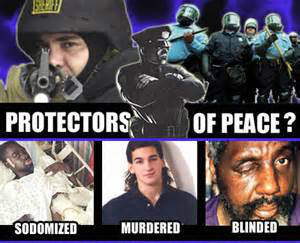The weekly murders of unarmed black men, not to mention those we don’t know about, at the hands of the police have reached epidemic proportions. To be clear, the African American community have cried and voiced concerns since the days of the “slave catchers” – who are tantamount to today’s police forces. History reports that this is not a new phenomenon; it goes back to the fear resulting from Nat Turner and slavery. To include all of the instances where the police became judge, jury, and executioner.
Make no mistake, police brutality to this magnitude or on any level would NEVER occur in the white, Jewish, or any other communities. Never, they would not stand for it – period! So the question then become why does it happen over and over to people of color at such an alarming rate? Of late, the brutality, excessive force, and killings have escalated, or should I say murder, at a rate of one per day!
The abuse of authority by police is the infliction of excessive force by personnel involved in various aspects of the performance of their official duties. While the term police brutality is usually applied in the context of causing physical harm, it may also involve psychological harm through the use of intimidation tactics beyond the scope of officially sanctioned police procedure. However, in many cases it is sanctioned by agencies and trained by such agencies in the art of war on the black community. More often than not, these agencies engage in a subsequent cover-up of their illegal activity.
The word “brutality” has several meanings; the sense used here (savage cruelty) was first used in 1633. The first known use of the term “police brutality” was in the New York Times in 1893, describing a police officer’s beating of a civilian. Efforts to combat police brutality focus on various aspects of the police subculture, and the aberrant psychology that may manifest itself when individuals are placed in a position of absolute authority over others. A main cause that supports the unlawful actions of the police is that courts cannot or choose not to see systemic patterns of police brutality. This means they simple use of the word “justified” gives the police a license to kill. Therefore, based on its long history it is believed that without substantial social change, the control of police deviance is improbable at best.
In the United States, the passage of the Volstead Act, popularly known as the National Prohibition Act in 1919, had a long-term negative impact on policing practices. By the mid-1920s, crime was growing dramatically in response to the demand for illegal alcohol. Many law enforcement agencies stepped up the use of unlawful practices. Police brutality can be directly connected to racial profiling and War on Drugs. As a result, African American’s, in particular, perceive the police to be oppressors. In addition, there is a perception that victims of police brutality often belong to relatively powerless groups, such as minorities, the young, and the poor.
The Civil Rights Movement has been the target of numerous incidents of police brutality in its struggle for justice and racial equality, most notably in places like Birmingham and Selma. In the United States, race and accusations of police brutality continue to be closely linked, and the phenomenon has sparked a string of race riots over the years in nearly every city. The atmosphere was made more volatile and visible because the brutality has been videotaped by a bystander and widely broadcast afterward.
Numerous human rights observers have raised concerns about increased police brutality in the wake of the 911 attacks and the War on Terror that has created a generalized climate of impunity for law enforcement officers. This is viewed as contributing to the erosion of what few accountability mechanisms exist for civilian control over law enforcement agencies. As a result, police brutality and abuse persist unabated and undeterred across the country.
While the prevalence of police brutality in the United States is not comprehensively documented, statistics on police brutality are much less available. The few statistics that exist include a 2006 Department of Justice report. Which showed that out of 26,556 citizen complaints made in 2002 about excessive use of the police force among large U.S. agencies (representing 5% of agencies and 59% of officers), about 2000 were found to have merit. Yet only 30 percent of those who acknowledged such brutality filed formal complaints.
It has been noted that local media rarely report scandals involving the police unless there is videotape evidence. There is often a dramatic increase in unfavorable attitudes toward the police in the wake of highly publicized events. Most of these brutality cases or murders of black people at the hands of the police are viewed as “nothing to see here” because the attitude is that “those people” deserve it”.
As a result of what we saw in the Ferguson, New York, South Carolina, Cleveland, Oklahoma, and in fact all over the country we see that the police cannot be trusted nor left to police themselves. You could be next! And that’s my thought provoking perspective…
A list of police brutality cases
Forty years ago, Gil Scott Heron told use this day would come “it feels like winter in America because nobody knows what to say”. Except, the Revolution will be televised!!!









Leave a comment